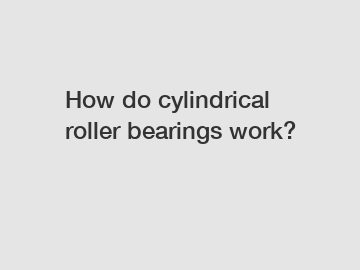How do cylindrical roller bearings work?
How do cylindrical roller bearings work?
Cylindrical roller bearings are an essential component in many machines and vehicles, providing support, reducing friction, and enabling smooth rotation. But how exactly do they work, and what makes them so crucial in various applications? In this article, we will delve into the intricate workings of cylindrical roller bearings, exploring their design, structure, and practical applications.
1. Definition: .

Cylindrical roller bearings are rolling bearings with cylindrical rollers arranged in a line parallel to the axis of rotation. These rollers provide a larger contact area, enabling them to support heavier loads compared to ball bearings.
2. Structure and Design:
Cylindrical roller bearings consist of an inner ring, an outer ring, cylindrical rollers, and a cage. The inner and outer rings act as raceways for the rollers and are separated by the roller set held in place by the cage. This design ensures that the rollers can move independently, minimizing friction and distributing loads evenly.
3. Load Capacity:
One of the significant advantages of cylindrical roller bearings is their ability to support both radial and axial loads. The cylindrical roller's contact line with the raceways enables them to distribute loads more effectively. Due to their higher load-carrying capacity, these bearings are commonly used in heavy machinery applications such as mining equipment, wind turbines, and construction machinery.
4. Types of Cylindrical Roller Bearings:
There are various types of cylindrical roller bearings available, each serving specific purposes. These include:
a. Single-Row Bearings: These bearings consist of a single row of cylindrical rollers. While they can support radial loads, their axial load-carrying capacity is limited.
b. Double-Row Bearings: Double-row cylindrical roller bearings have two rows of rollers, enabling them to carry higher radial loads. They can also handle limited axial loads.
c. Full Complement Bearings: Full complement cylindrical roller bearings have no cage, allowing for maximum roller quantity. As a result, they offer exceptional load-carrying capacity but are less suitable for high-speed applications.
d. Multi-Row Bearings: These specialized bearings have multiple rows of rollers, providing higher load-carrying capacity. They are commonly used in heavy machinery applications, including rolling mills and gearboxes.
5. Lubrication:
Proper lubrication is crucial for the efficient functioning of cylindrical roller bearings. Lubricants not only reduce friction but also help prevent wear and corrosion. Common lubrication methods include grease and oil lubrication, with the selection depending on factors such as operating speed and temperature.
6. Mounting and Maintenance:
Accurate mounting and regular maintenance are essential to ensure the longevity of cylindrical roller bearings. Improper mounting can lead to premature failure or reduced performance. Maintenance tasks include monitoring lubrication levels, checking for wear or damage, and verifying proper alignment.
7. Applications:
Cylindrical roller bearings find widespread use in numerous industries and applications, including:
a. Automotive: These bearings are used in car wheels, transmissions, and engines to provide smooth and efficient operation.
b. Industrial Machinery: From conveyor systems to power plants, cylindrical roller bearings are employed in a wide range of industrial machinery applications.
c. Aerospace: The aerospace industry relies on cylindrical roller bearings for various aircraft components, including landing gear and engine components.
d. Medical Equipment: Precision equipment such as MRI machines and X-ray devices often incorporate these bearings for their exceptional load-carrying capacity and smooth operation.
8. Advancements and Future Trends:
With the continuous advancement in technology, cylindrical roller bearings are expected to evolve further. Manufacturers are investing in research and development to enhance bearing materials, lubrication options, and reduce friction. This progress aims to improve performance, increase reliability, and reduce maintenance requirements in various sectors.
In conclusion, cylindrical roller bearings are an integral part of numerous machines and vehicles, enabling smooth rotation, reducing friction, and maximizing load-carrying capacity. Their robust design, various types, and ability to handle both radial and axial loads make them indispensable in numerous industries. With ongoing advancements, these bearings are continuously improving, ensuring enhanced performance and longevity in the future. So, next time you come across a machine with a cylindrical roller bearing, you will have a deeper understanding of how it works and its vital role in the smooth functioning of the machinery.
The company is the world’s best Chain Conveyor Trolley Wheels, Overhead Conveyor trolley wheel 4", Overhead Conveyor Side Roller supplier. We are your one-stop shop for all needs. Our staff are highly-specialized and will help you find the product you need.
135
0
0


Comments
All Comments (0)